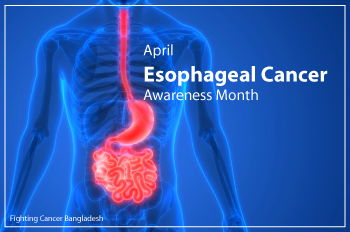
Esophageal cancer originates in the presence of a malignant tumor that can be present in any part of the esophagus or digestive tract and later spread to other parts of the body. The esophagus refers to the vital body organ that functions to establish contact from the throat to the stomach. Esophageal cancer is the second most common form of gastric cancer, and its risk is significantly increased after the age of 50. At present, there is a risk of cancer in young people due to some influential factors, including uncontrolled and irregular eating. Every year, April is observed as the Esophageal Cancer Awareness Month.
Although Esophageal cancer is divided into four categories, the two main subtypes are more common. One is squamous cell carcinoma which arises from the cells in the upper part of the esophagus. The other is esophageal adenocarcinoma, which is caused by uncontrolled changes in glandular cells at the junction of the esophagus and stomach.
Even though the specific causes of esophageal cancer are yet to be reported, it is essential to examine specific factors such as uncontrolled eating habits and lifestyle patterns, family history, previous experience with risk-taking diseases, smoking, and drinking habits.
The initial symptoms are discomfort in eating and swallowing, burning sensation in the chest or heartburn, and weight loss. In 90-95% of cases, the cancer is usually reported to spread far and wide, and the symptoms seem to appear in the final stage. At this point, the patients start feeling nauseous and frequently vomiting due to severe difficulty in eating and swallowing, particularly solid foods. Anemia, dehydration, severe weakness may occur as well. In severe cases, food can pass from the esophagus into the mouth, especially while the patient is lying down.
Every year, during the month of April, various initiatives are taken to create and spread awareness among people of all sectors to prevent esophageal cancer. Public and private hospitals and health complexes set up information centers or booths in their respective areas as well as at important checkpoints all over the country. This makes it possible to provide details about esophageal cancer to the general public and patients seeking medical care at the hospitals. Different voluntary and social welfare organizations also set up information centers and send volunteer teams to residential areas, educational institutions, and other important places to distribute leaflets and booklets containing detailed information on esophageal cancer (symptoms, causes, diagnosis, treatment, precautions). Medical professionals, healthcare providers, caregivers, and volunteers play an important role in creating awareness among mass people, particularly in rural or remote areas. In rural areas, volunteer teams are sent to cover every house to make the awareness campaign more effective. Attempts are also made to increase the level of awareness by spreading all the information related to esophageal cancer in the traditional mass media and social media platforms throughout the month.
Although the origin of any cancer might be due to various reasons, to prevent the uncontrolled spread of cancer, it is vital to know every aspect of the disease in detail, raise awareness about it, and consult medical specialists for appropriate treatment on time. With a similar view to raising awareness for Esophageal cancer, April month is considered the awareness month.

